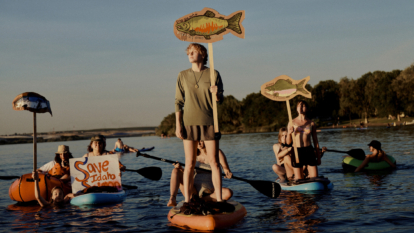If Nothing Changes, Everything Changes
Those with the most to lose are uniting to save the Northwest’s salmon and steelhead.
All photos by Mason Trinca
Ice Harbor Dam chokes the Snake River near its confluence with the Columbia River in Burbank, Washington, a small agricultural town born after America’s 10th largest watershed was turned into a placid shipping corridor.
Standing atop the dam, the sun climbs in the cloudless desert sky beating down on 12 hard hat–clad high schoolers as they pummel their unsuspecting tour guide with thinly veiled accusations and less-than-subtle corrections.
“That’s the production capacity of this dam, not the actual energy produced,” Henry Roller interrupts as the guide rattles off a list of hydropower statistics. “None of these dams have ever created anything close to their listed capacities. Isn’t it true the lower Snake River dams (LSRDs) only collectively create, like, 1,000 megawatts? Isn’t that, like, a third of their capacity? Not to mention, isn’t a lot of the power produced by these dams surplus and sold at a loss?”
“I wouldn’t want to tell you something that isn’t true. I’ll have to look more into that,” the overwhelmed guide stutters.
Throughout the tour, the guide—a volunteer and a Burbank local—is a good sport as he bobs and weaves around questions. It’s obvious this won’t be a standard Saturday afternoon tour of the facility he’s usually sharing as a point of pride for his community.
“What is it about these dams that you’re so attached to?” Lizzy Duke-Moe asks, without shifting her gaze from the warm lake behind the dam.
“It’s emotional. These dams have been here my entire life,” the volunteer responds without hesitation. “They supply jobs. They support industry. They’re all I’ve ever known.”
Duke-Moe gulps, dissatisfied.
“I can sense what you’re here for, and while I don’t personally agree with you, I support you,” the guide says as he removes his hard hat and wipes his sweat-drenched brow. “You’re the future of America, and it’s necessary for you to challenge the status quo … that’s progress. That said, I believe in the rule of law. If they [elected officials] wish for the dams to come out, then they should be removed. But not until then.”
Well-intentioned as they may be, exchanges such as this one are commonplace for members of the Boise-based organization Youth Salmon Protectors (YSP). All too often, these leaders of the generation with the most to lose are told everyone depends on them to save us from ourselves.
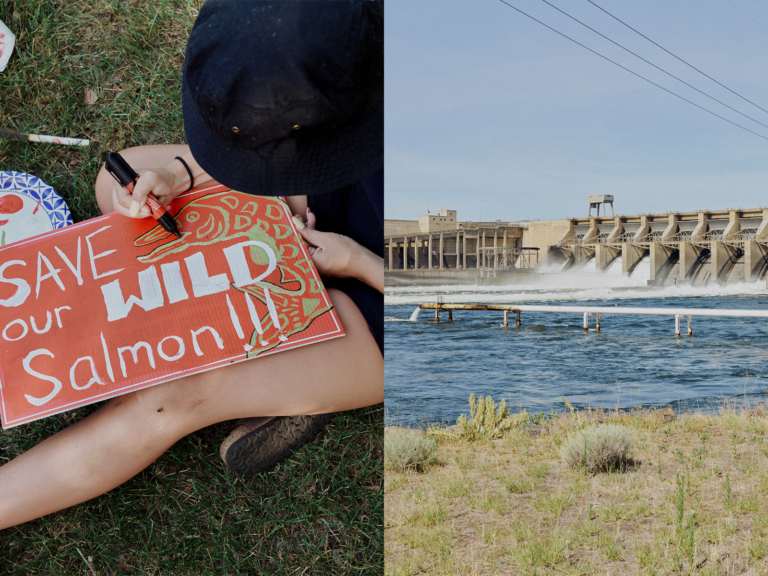
Left: Flying the fish flag. A member of Youth Salmon Protectors prepares a poster before a protest rally on the Snake River.
Right: Old and in the way. Seen from the banks of the Snake River near Burbank, Washington, the Ice Harbor Lock and Dam has turned one of the most productive salmon rivers in the world into a featureless shipping corridor.
Historically, millions of adult salmon and steelhead have returned to Idaho’s rivers each year. But Snake River fisheries crashed after the construction of the lower Snake River dams—Ice Harbor, Lower Monumental, Little Goose and Lower Granite—in the 1960s and ’70s.
More than $19 billion of Bonneville Power Administration ratepayer and taxpayer dollars have been spent as fish stocks continue to decline in what can only be described as a catastrophic failure to mitigate the impact of the dams.
In no uncertain terms, scientific consensus has identified the removal of the LSRDs as the lynchpin to restoring Idaho’s salmon and steelhead populations—which are listed under the Endangered Species Act.
The proof of the need to remove the LSRDs lies in the clear differences in the smolt-to-adult return (SAR) rates above and below the LSRDs. SAR is the percentage of the total number of ocean-bound juvenile fish that successfully return from their time in the ocean as adults to the freshwater streams of their birth to spawn. Salmon and steelhead returning to the Yakima River basin—below the LSRDs—must only traverse four dams. They can maintain SARs nearly three times as high as populations returning upstream of Lower Granite–the farthest upstream dam on the lower Snake River—where SARs are as low as 0.9 and 1.3 percent for Chinook salmon and steelhead, respectively.
To rebuild healthy and harvestable salmon and steelhead populations in the Snake River, four adult fish must return for every 100 smolts that migrate out to the ocean.
Two percent is necessary to avoid extinction.
In Idaho, the line between extinction and existence is not a line in the sand. It’s four concrete monoliths spanning the Snake River’s black basalt canyon from wall to wall.
“Restoring Idaho’s salmon and steelhead, shaping the future of the Northwest with climate and tribal justice will be the largest-scale conservation project in history, and being like salmon is how we’ll get there.”
“Idaho’s salmon and steelhead are who I am,” Shiva Rajbhandari, the 18-year-old co-leader of YSP, tells me during our initial meeting in the parking lot of the Boise Co-Op. Despite dark curls that pour over round, youthful cheeks, Rajbhandari stands tall with the chest-out confidence of a much older man.
“Salmon and steelhead have the grit it takes to complete hard things. To push the boulder up the hill,” he continues. “Restoring Idaho’s salmon and steelhead, shaping the future of the Northwest with climate and tribal justice will be the largest-scale conservation project in history, and being like salmon is how we’ll get there.”
Launched in 2018, the Youth Salmon Protectors want to restore salmon throughout the Northwest by removal of the lower Snake River dams, while instilling tribal and climate justice across the Pacific Northwest (PNW). A program of the Idaho Conservation League, at the time of this reporting, the group was collaboratively spearheaded by a dynamic pair of Boise High School students, Rajbhandari and co-leader, Duke-Moe, who is now attending Brown University.
This past September, Rajbhandari, running on a platform of climate change and mental health, became the first student in history elected to the Boise School District board of trustees, defeating an incumbent school board member backed by fundamentalist far-right group, the Idaho Liberty Dogs, by nearly 2,500 votes.
“We cannot back down to bullies like the Idaho Liberty Dogs and the so-called Boise School District Parents’ Association,” Rajbhandari said in a statement released on his 18th birthday, just days before the election. “Our community values love over hate and compassion over indifference. These characteristics are showcased every day by my peers and teachers. As the first-ever student to serve on the school board, I will represent these values.”
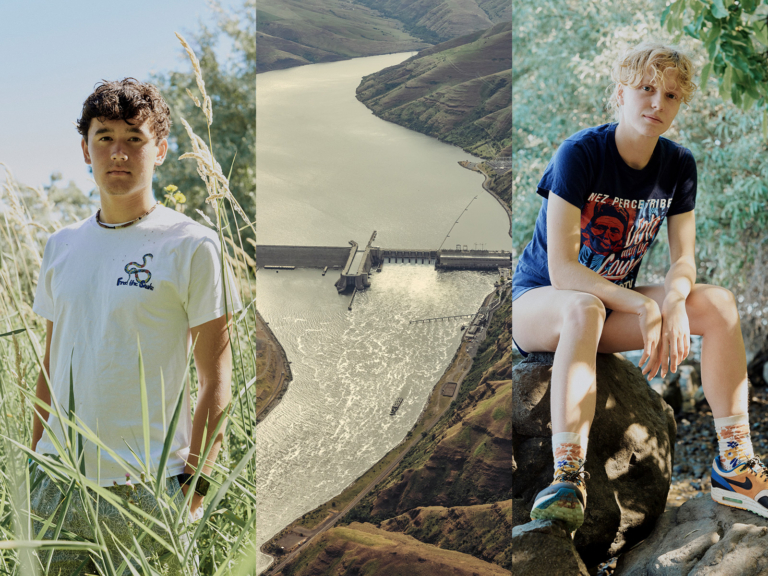
Left: Shiva Rajbhandari is one of the leaders of Youth Salmon Protectors. In September 2022, he was elected to the Boise School District board of trustees, the first-ever student to serve on the board.
Middle: In a 2022 report on Columbia River basin salmon and steelhead, the National Marine Fisheries Service, a division of the National Oceanic and Atmospheric Administration (NOAA), concludes, “The science robustly supports riverscape-scale process-based stream habitat restoration, dam removal (breaching) and ecosystem-based management, and overwhelmingly supports acting, and acting now.”
Right: Former Boise High School student body president and current student at Brown University, Lizzy Duke-Moe is one of the leaders of Youth Salmon Protectors.
Later, I sit down with Duke-Moe at her favorite coffee shop in downtown Boise. Between sips of chai, she explains how when she joined the YSP at 16 years old, she felt as if she was late to the game.
“We need to focus on getting every voice to the table. Now. We don’t have time to get our voices dismissed as ‘rebellious youth.’”
“I remember being in 8th grade, shocked there were no books about LGBTQIA+ communities in the library,” Duke-Moe explains. “So, I asked the librarian, who told me it was only because no one had asked for any before. She asked me to make a list of what I would like. I did, and she put them in.”
“My own identity as a gay girl raised by lesbian parents in Boise has played a huge part in shaping my perspective on advocacy and leadership,” Duke-Moe acknowledged, mentioning that years after getting those books in the library, she organized a community workshop around LGBTQIA+ rights in her community.
“Thank you for putting this together. I feel bad you have to grow up in this environment. I’m sorry. I feel guilty, and I feel so lucky people like you will be in control in the future,” Duke-Moe remembers being told by a woman after the workshop.
“It was jarring for this woman to apologize, probably mostly to make herself feel better and tell me that she’s waiting for me to make changes. I appreciate the intention. I know she meant it as a compliment to me, but it’s always so frustrating to hear,” Duke-Moe tells me. “This woman, maybe 55 years old, who has infinitely more resources than me, is waiting for me to make changes.”
“If a young, queer, blonde teenager from Idaho can make this happen,” Duke-Moe adds confidently, her eyes dancing over the rim of her steaming mug, “anyone can.”
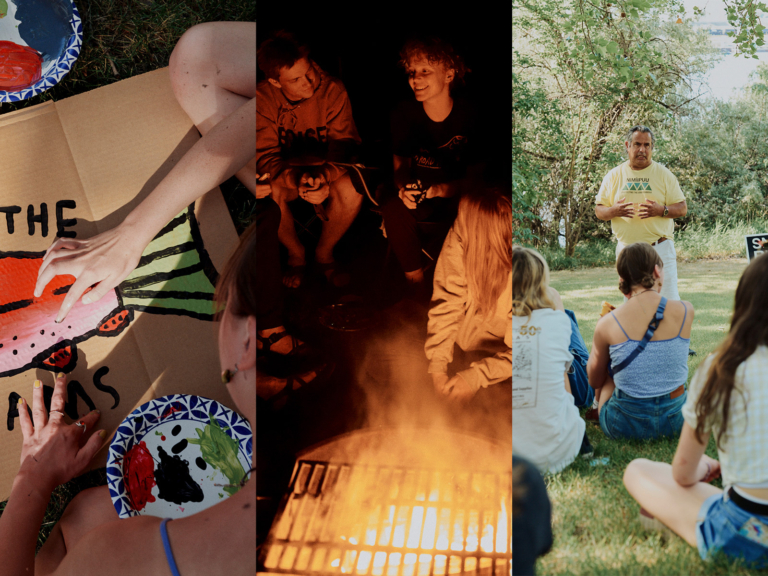
Left: Signs for salmon. Prior to an anti-dam demonstration flotilla near the Snake River’s Ice Harbor Lock and Dam, Youth Salmon Protectors activists ready their protest posters.
Middle: Members of Youth Salmon Protectors share s’mores and salmon tales during an overnight protest near the Snake River’s Ice Harbor Lock and Dam.
Right: Nimíipuu Protecting the Environment coordinator Julian Matthews speaks to the Youth Salmon Protectors during their Ice Harbor Lock and Dam protest.
After their sobering tour of Ice Harbor, the YSP migrated to a mobile base camp—a nearby campground—for their regional meeting. The gloomy mood intensifies when the cagey camp hosts insist they move any anti-dam signage out of public view—allegedly having received complaints from surrounding campers.
The dark cloud looming over YSP’s camp lifts when the group gathers to listen to Nez Perce tribal member and Nimíipuu Protecting the Environment coordinator Julian Matthews.
“I served this country. I am a veteran. I graduated from Gonzaga. I own a home and pay taxes. I am also a tribal member. I hunt, fish and gather. I am not a second-class citizen,” Matthews says with a painful chuckle. His charisma strikes a chord with the youth advocates, frustrated with their own feelings of disenfranchisement.
The Nez Perce Tribe is at the center of the decades-long battle to remove the LSRDs. In many tribal members’ lifetimes, dams have transformed the Columbia and Snake from wild to working rivers—hydropower behemoths and shipping channels—despite fishing rights reserved by their ancestors and guaranteed by the United States government in the treaty of 1855. Salmon and steelhead are pivotal to the continuance of traditional Indigenous culture. For many tribes across the PNW—the Nez Perce included—the fish play central roles in their origin stories.
“The young people coming up through Nimíipuu Protecting the Environment and YSP, these are the future mayors, city councilors and tribal leaders of our respective communities,” Matthews supposes, his tone more literal than hyperbolic. “It’s our goal to engage our youth and foster a connection between our communities. Together, they will lead us into our future.”
I ask Matthews if—and how—a group of mostly white, non-tribal city folks can advocate for tribal justice without tokenizing Indigenous voices.
“Meetings like this between tribal and non-tribal youth provide much-needed space for tribal voices to speak for themselves. They can connect and better speak in one voice. No one needs to speak for anyone,” Matthews says.
That night, the YSP gather in a circle around a bonfire where one by one, over cold pizza and s’mores, members from across the Northwest share their relationships to not only the fish but also what the removal of the LSRDs would mean for the communities they call home.
Roller, who drove by himself from Seattle, tells the group how a calf had been born into the K Pod of the Southern Resident orcas only one week before this gathering. It’s the first calf born in 11 years to that segment, endangered due to their dwindling food supply of wild adult Chinook salmon.
Scout Alford, the leader of the Lewiston, Idaho, chapter of YSP, shares how her grandparents tell stories of her hometown—the farthest inland port city in the West—as a beautiful riverside town with a powerful free-flowing river and sandy beaches. The Snake River Alford knows has limited access due to being lined with riprap to maintain the shipping corridor. The beaches have all but vanished. The Lewiston her grandparents remember so fondly is a town she’s never known but aspires to restore.
Connor McCall, from the Boise chapter, readily admits he is an angler and hopes to see fish return to historical abundance simply because he wants to be able to catch and keep more fish. Accepted with varying enthusiasm around the waning fire, the sentiment shows the diversity of interests across the YSP.
When it comes time for Rajbhandari to speak, he assumes his position as instigator and rallies the troops.
“As many of you know, I love to run. This summer, I’m committed to running 900 miles, the distance Idaho salmon have to swim upstream to spawn. When I run, salmon are my inspiration. Whenever I do anything difficult, I think of the grit salmon have. When facing something so big, like breaking down these dams, we have to remember we’ve done big things before. We can do it again. But that means you have to do the hard things, and grit is what is going to get us there,” Rajbhandari says, his voice rising to a crescendo through the monologue.
After a long day, it’s timely.

Left: Honk for habitat! Youth Salmon Protectors protest on US Highway 12 bridge over the Snake River near Burbank, Washington.
Right: What’s got these kids so fired up? Breaching the four lower Snake River dams, honoring tribal treaties and saving wild salmon and steelhead.
The chants rebound off the steel bridge of US 12 as it crosses hundreds of feet above the Snake River, only a stone’s throw from YSP’s riverside base camp.
WHAT DO WE WANT?
REMOVE THE DAMS!
WHEN DO WE WANT IT?
NOW!
WHAT DO WE WANT?
TRIBAL JUSTICE!
WHEN DO WE WANT IT … NOW!
In the center of the bridge, dozens of hands hold a 25-foot-wide banner reading “Free the Snake, Honor Tribal Treaties,” in a font large and bold enough to be read clearly from the one-horse town of Burbank to the west and by the empty barges heading upriver toward Ice Harbor, below. Others hold handmade depictions of various species of salmon and steelhead.
Watching the scene unfold on the bridge, I wonder about the tangible impact of demonstrations like this. Trucks lay on their horns as they blitz past at nearly 80 miles per hour, the sound reverberating off the metal structure making it impossible to know if it means “keep it up” or “get lost.”
“A lot of the more radical actions that have been taken in the past by other activist groups, like vandalizing structures and burning things down, I don’t think we have time for all the distractions they cause,” Duke-Moe explains. “We don’t have time for it, and the salmon don’t have time for it. We need to focus on getting every voice to the table. Now. We don’t have time to get our voices dismissed as ‘rebellious youth.’”
Exiting the bridge after rolling up their signs and waving to the last truck driver, the YSP are overflowing after their cathartic release. Walking to the bridge, they were focused and quiet, but now they’re howling with laughter and ping-ponging off each other in the narrow metal walkway.
“True conversation is only possible with a power balance,” Rajbhandari tells me as we walk off the bridge. “It is important to know when to lower the volume and talk. But, sometimes, you have to be stubborn and fight to gain power. There’s a time to talk and a time to fight. It’s important to recognize them as different, but they’re both important.”
Today, deep in the belly of the beast, they screamed, and whether anyone was listening was beside the point.
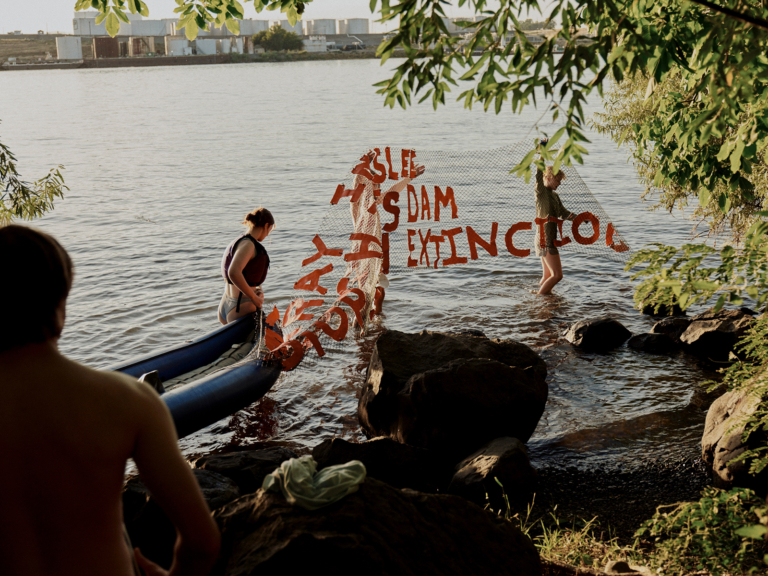
In the shadow of the Snake River’s Ice Harbor Lock and Dam, Youth Salmon Protectors take to the water to save wild salmon and steelhead.
“If they were here, they would be taking action. Now.” Rajbhandari says forcefully. The “they” he’s referring to is Idaho’s former Governor Cecil Andrus and former Senator Frank Church, who US Senator Ron Wyden quoted when he spoke at an event at the Cecil Andrus Center in Boise in 2021.
Kathleen Cathey, a field representative for Senator Wyden, sits across from Rajbhandari in a quiet cafe in sleepy La Grande, Oregon. The Oregon Democratic Party staffer is surrounded by nearly two-dozen sweat-soaked, mostly Idaho-based YSP, just arriving from the three-hour drive across Oregon’s rolling highlands directly from the banner drop.
“What can YSP do to encourage more direct action from the Senator regarding the lower Snake River dams?” Duke-Moe offers while Cathey is considering how to respond to Rajbhandari’s jab.
Cathey informs the YSP that the most helpful thing would be to speak with Oregon YSP members from the Senator’s jurisdiction, of which none are present.
“We can do that!” Duke-Moe bursts out, realizing the error of their ways. “We have a growing number of Oregon members. We just got done with a big meeting, and a lot of the Oregon folks had to head home. We can definitely make that happen.”
After shaking hands and parting ways, the YSP spills out onto Main Street, where, undeterred, Duke-Moe is off to the side, furiously texting.
She’s coordinating the next meeting with the senator’s office, this time with local YSP members.
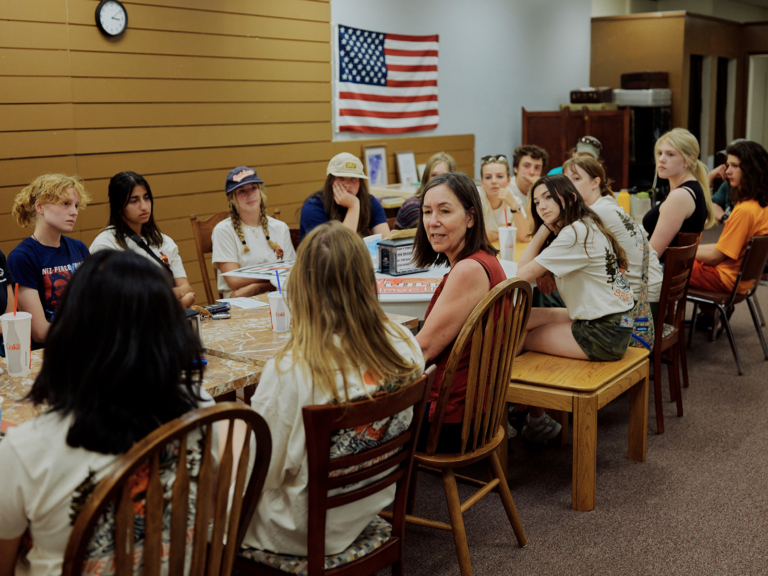
Kathleen Cathey, an assistant to US Senator Ron Wyden (D-OR), takes a turn in the hot seat while talking to Youth Salmon Protectors in La Grande, Oregon.
Driving home to Boise, the rolling hills of wheat and barley in eastern Oregon and southwest Idaho provide ample time and space to consider the questions weighing heavily on the minds of YSP.
Will this be enough? The endless meetings with local, regional and federal elected officials. The hundreds of thousands of postcards, phone calls and emails. The carefully curated demonstrations.
Is it too little, too late?
YSP doesn’t spend too much time pointing fingers or playing blame games. They’re anxious they don’t have time to argue. They don’t care whose fault it is. They need it fixed before it’s too late.
One thing the YSP are certain of is that if nothing changes, everything will change. The Snake River and Idaho’s salmon and steelhead only have a few generations before extinction is imminent. In less time than most members of the YSP have been alive, they could be damned to be the first humans to live in a time without wild Snake River salmon and steelhead.
Regardless of whether they were responsible for it—irrespective of the work they are willing to do in the future.
“This work is forever,” Rajbhandari says, laying out the realities YSP faces daily. “It’ll never go away, but it’s crucial now. The reality is my kids will not have the same opportunity to apologize and hope that future generations will do what we know will restore our salmon and steelhead and establish climate and tribal justice. We only have so much time. We can’t wait.”
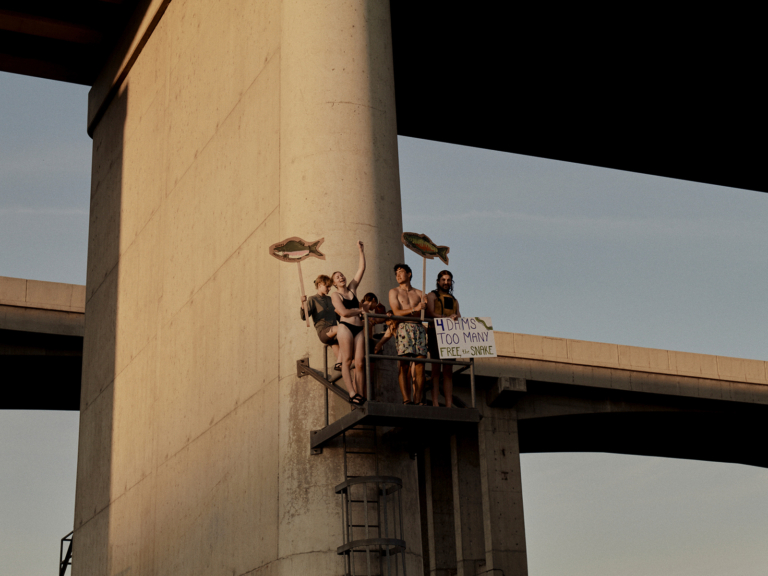
“We need to focus on getting every voice to the table. Now. We don’t have time to get our voices dismissed as ‘rebellious youth,’” says Lizzy Duke-Moe.
Go deeper: Patagonia Film’s 2014 documentary DamNation and Patagonia Books’ 2023 publication Cracked: The Future of Dams in a Hot, Chaotic World (by Steven Hawley) highlight the ecological need and opportunity to breach fish-killing dams and reconnect rivers.
